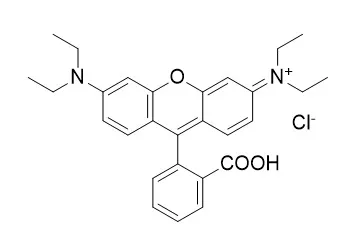| In vitro: |
| Photochem Photobiol Sci. 2017 Oct 30. | | Fluorescence lifetime of Rhodamine B in aqueous solutions of polysaccharides and proteins as a function of viscosity and temperature.[Pubmed: 29083002 ] | Rhodamine B (RhB) is a well known dye extensively used in thermometric studies, either considering the decrease in the fluorescence intensity or the lifetime (τ) with temperature. Lifetime measurements are preferred over intensity ones as they are more robust.
METHODS AND RESULTS:
In order to expand microscopy thermometry to complex food fluids, the effect of solutes on the τ of RhB was studied using fluorescence lifetime imaging microscopy (FLIM) in a two-photon microscope. Polysaccharides of different molecular weights (glucose, lactose, dextran, maltodextrin, and sodium alginate), as well as whey proteins, were considered as typical model food ingredients. A linear increase in τ with the concentration is observed in most polysaccharides, highlighting that it is not due to an increase in the macroscopic viscosity, but in maltodextrins a Langmuir-like concentration dependence is observed. There are extensive interactions between RhB and whey proteins at small concentrations that quickly increase τ up to saturation at >10 wt% proteins, with τ modelled well using an adsorption Langmuir model.
CONCLUSIONS:
Therefore, the effect of solutes on RhB τ is not related to changes in the macroscopic viscosity. The temperature sensitivity of τ, quantified using apparent activation energies, decreases at high solute contents. | | ACS Appl Mater Interfaces. 2017 Oct 25;9(42):36561-36572. | | Nanoprobe Synthesized by Magnetotactic Bacteria, Detecting Fluorescence Variations under Dissociation of Rhodamine B from Magnetosomes following Temperature, pH Changes, or the Application of Radiation.[Pubmed: 29035036 ] |
METHODS AND RESULTS:
We report a method of fabrication of fluorescent magnetosomes, designated as MCR400, in which 400 μM of Rhodamine B are introduced in the growth medium of AMB-1 magnetotactic bacteria and fluorescent magnetosomes are then extracted from these bacteria.
These fluorescent magnetosomes behave differently from most fluorescent nanoprobes, which often lead to fluorescence losses over time due to photobleaching. Indeed, when MCR400 are heated to 30-90 °C, brought to an acidic pH, or exposed to radiations, we observed that their fluorescence intensity increased. We attributed this behavior to the dissociation of Rhodamine B from the magnetosomes. Interestingly, enhanced fluorescence was also observed in vitro when MCR400 were mixed with either primary macrophages or tumor cells (TC1-GFP or RG2-Cells) or in vivo when MCR400 were introduced in rat glioblastoma.
CONCLUSIONS:
We showed that MCR400 internalize in tumor and immune cells (macrophages) leading to enhanced fluorescence, suggesting that fluorescent magnetosomes could be used during cancer treatments such as magnetic hyperthermia to image cells of interest such as immune or tumor cells. |
|






 Cell. 2018 Jan 11;172(1-2):249-261.e12. doi: 10.1016/j.cell.2017.12.019.IF=36.216(2019)
Cell. 2018 Jan 11;172(1-2):249-261.e12. doi: 10.1016/j.cell.2017.12.019.IF=36.216(2019) Cell Metab. 2020 Mar 3;31(3):534-548.e5. doi: 10.1016/j.cmet.2020.01.002.IF=22.415(2019)
Cell Metab. 2020 Mar 3;31(3):534-548.e5. doi: 10.1016/j.cmet.2020.01.002.IF=22.415(2019) Mol Cell. 2017 Nov 16;68(4):673-685.e6. doi: 10.1016/j.molcel.2017.10.022.IF=14.548(2019)
Mol Cell. 2017 Nov 16;68(4):673-685.e6. doi: 10.1016/j.molcel.2017.10.022.IF=14.548(2019)